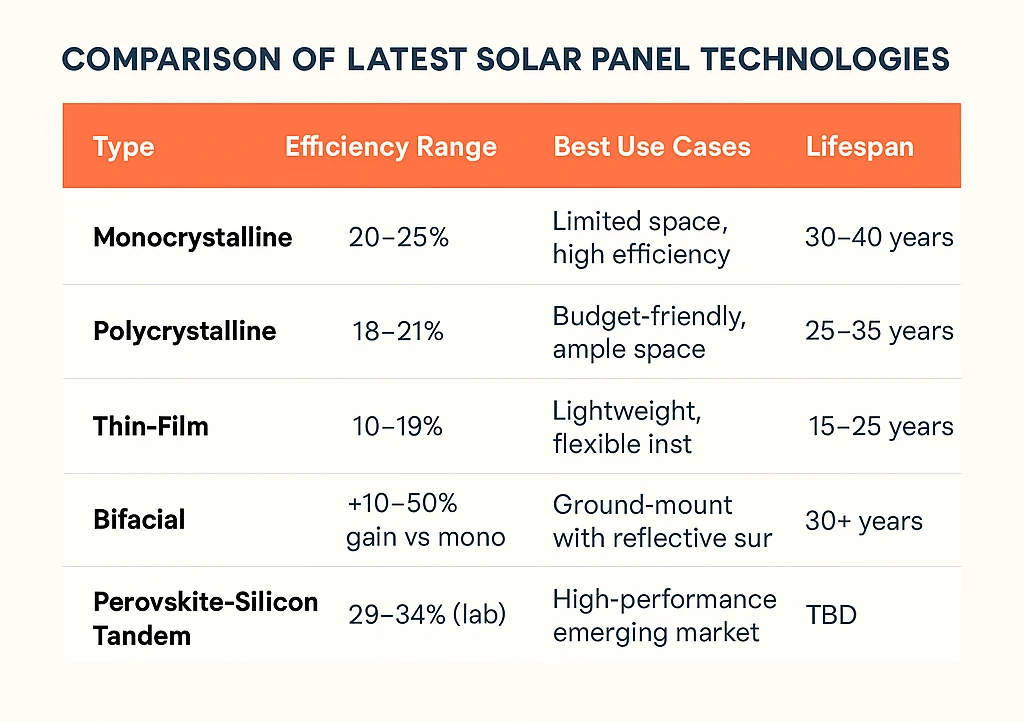The solar industry has seen rapid advancements in the last decade, and 2025 is shaping up to be another breakthrough year. With growing concerns about climate change and the global shift toward renewable energy, solar panel technology is evolving to become more efficient, cost-effective, and widely accessible. Let’s explore how it works, the current innovations, and what you can expect in the near future.

How Solar Panel Technology Works
At its core, solar panel technology is based on the photovoltaic (PV) effect. When sunlight hits the solar cells, typically made of silicon, it knocks electrons loose, generating an electric current. This current is then converted from direct current (DC) into alternating current (AC) through an inverter, making it usable in homes, businesses, and industries.
The efficiency of solar panels depends on several factors, such as cell design, materials, and energy conversion capabilities. Traditional silicon panels dominate the market, but newer technologies are pushing the boundaries of efficiency and sustainability.
Latest Innovations in Solar Panel Technology
In 2025, the solar industry is embracing groundbreaking innovations that are making panels smarter and more powerful:
- Perovskite Solar Cells
Perovskite cells are lightweight, flexible, and capable of achieving high efficiency at lower production costs. They have the potential to surpass traditional silicon panels by delivering efficiency rates above 30%. - Bifacial Panels
These panels capture sunlight from both the front and the back, significantly improving overall energy yield. Bifacial designs are especially useful in large-scale solar farms where reflective surfaces enhance energy production. - Building-Integrated Photovoltaics (BIPV)
A major trend in solar panel technology is the integration of PV cells into building materials, such as windows, facades, and roofing tiles. This not only generates power but also adds aesthetic value to modern architecture. - Solar Tracking Systems
Modern panels are increasingly paired with smart tracking systems that follow the sun’s movement throughout the day. This can boost energy output by 30–40% compared to fixed installations. - Transparent Solar Panels
Researchers are developing transparent panels that can be used in windows, car windshields, and even smartphone screens. This innovation could change how we think about energy generation in daily life.
Trends to Watch in 2025
As the world moves toward decarbonization, several trends are shaping the future of solar panel technology:
- Higher Efficiency Standards: Manufacturers are focusing on panels that exceed 25% efficiency while maintaining durability.
- Energy Storage Integration: Solar-plus-storage solutions are becoming mainstream, allowing homeowners and businesses to store excess energy for nighttime use.
- Smart Grids & IoT Integration: Solar panels will increasingly connect to smart energy management systems, enabling users to monitor and optimize energy consumption in real time.
- Sustainability in Manufacturing: Efforts are being made to reduce the carbon footprint of solar panel production through recycling and eco-friendly materials.
What to Expect Going Forward
Looking ahead, solar panel technology will continue to evolve rapidly. By 2025 and beyond, consumers can expect panels that are more affordable, durable, and adaptable to different environments. Solar will no longer be limited to rooftops and solar farms—it will be integrated into everyday life, from building materials to vehicles.
Governments are also supporting solar growth with subsidies and policies that encourage adoption. As costs decline and technology advances, solar power will solidify its role as a dominant source of clean energy worldwide.
Conclusion
The future of solar panel technology is bright. From perovskite cells to transparent panels, innovations are reshaping the renewable energy landscape. By 2025, solar will not just be an alternative—it will be a mainstream solution powering homes, businesses, and entire cities. For anyone looking to invest in renewable energy, now is the perfect time to explore the benefits of this ever-advancing technology.
